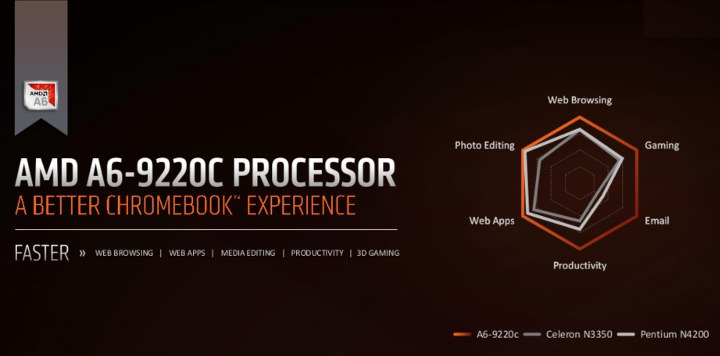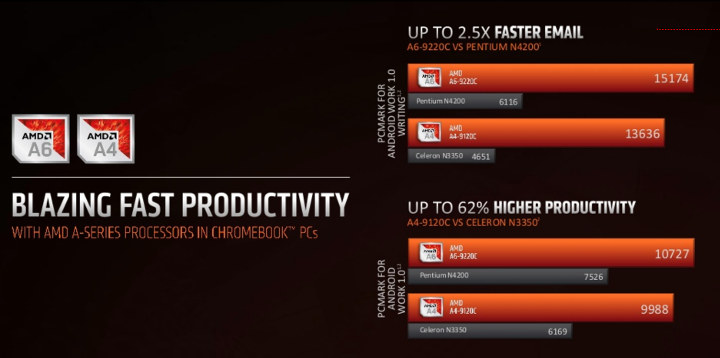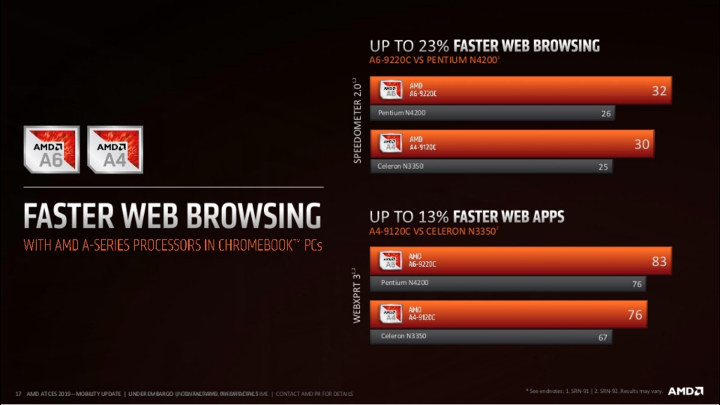Intel will usually release new low power processors under 10W TDP every year, but that has not been the case for AMD, with the company releasing several 12-15W processors in the recent past like Ryzen Embedded V1000 series and the Ryzen 7 2700U processor I’m currently using my Ubuntu laptop.
However, AMD has now announced two new A-series processors with a 6W TDP, namely A4-9120C and A6-9220C dual-core processors that specifically target Chromebooks.

AMD A4-9120C key features:
- Processor – 2x CPU cores, 2x CPU threads @ 1.6 GHz / 2.4 GHz (Boost)
- Cache – 160KB L1 cache, 1MB L2 cache
- GPU – Radeon R4 graphics with 3x GPU Cores up to 600 MHz, support for H.26x, VP9 decode
- Memory – Single channel @ 1866 MHz
- Video Output – HDMI and DisplayPort
- Process – 28nm CMOS
- Package – FT4
- TDP – 6 watts
AMD A6-9220C key features:
- Processor – 2x CPU cores, 2x CPU threads @ 1.8 GHz / 2.7 GHz (Boost)
- Cache – 160KB L1 cache, 1MB L2 cache
- GPU – Radeon R5 graphics with 3x GPU Cores up to 720 MHz, support for H.26x, VP9 decode
- Memory – Single channel @ 1866 MHz
- Video Output – HDMI and DisplayPort
- Process – 28nm CMOS
- Package – FT4
- TDP – 6 watts

Intel’s latest low power entry-level processor family is Gemini Lake, but AMD decided to compare their 7th Gen AMD A-Series processors to the previous generation Apollo Lake processor, and in some specific Android benchmarks the new dual-core AMD processors are much faster than their Intel quad-core counterparts. I’m not quite sure why they decided to run PCMark for Android benchmark on ChromeOS, but nevertheless “writing emails” is 2.5 times faster, and the productivity benchmark is 62% faster. Other benchmarks are also a bit faster with A6-9920C being up to 23% faster for web browsing compared to Intel Pentium N4200, as well as 42% faster for photo editing, and 43% faster for web gaming. They did not compare it to Gemini Lake because the latter would have been faster in some benchmarks, and it’s not good for marketing, and the new AMD A-series pricing looks to be closer to the one of Apollo Lake laptops.

The first Chromebooks to features the new processors will be Acer Chromebook 315 and HP Chromebook 14, expected in early 2019 for prices starting at $280 and $269 respectively. In theory, the new processors should also work with Windows 10 laptops or mini PCs, but AMD only mentions Chromebooks.
Via Liliputing

Jean-Luc started CNX Software in 2010 as a part-time endeavor, before quitting his job as a software engineering manager, and starting to write daily news, and reviews full time later in 2011.
Support CNX Software! Donate via cryptocurrencies, become a Patron on Patreon, or purchase goods on Amazon or Aliexpress




